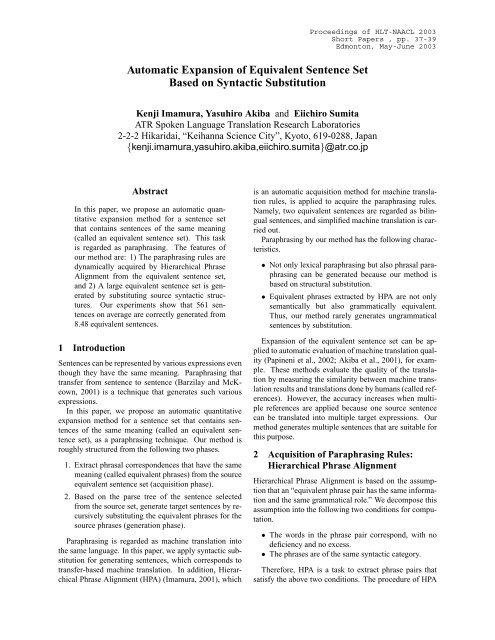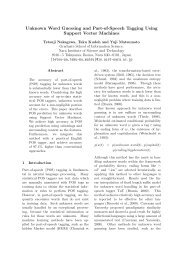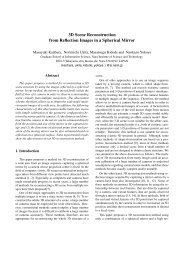Automatic Expansion of Equivalent Sentence Set Based on ...
Automatic Expansion of Equivalent Sentence Set Based on ...
Automatic Expansion of Equivalent Sentence Set Based on ...
Create successful ePaper yourself
Turn your PDF publications into a flip-book with our unique Google optimized e-Paper software.
<str<strong>on</strong>g>Automatic</str<strong>on</strong>g> <str<strong>on</strong>g>Expansi<strong>on</strong></str<strong>on</strong>g> <str<strong>on</strong>g>of</str<strong>on</strong>g> <str<strong>on</strong>g>Equivalent</str<strong>on</strong>g> <str<strong>on</strong>g>Sentence</str<strong>on</strong>g> <str<strong>on</strong>g>Set</str<strong>on</strong>g><br />
<str<strong>on</strong>g>Based</str<strong>on</strong>g> <strong>on</strong> Syntactic Substituti<strong>on</strong><br />
Proceedings <str<strong>on</strong>g>of</str<strong>on</strong>g> HLT-NAACL 2003<br />
Short Papers , pp. 37-39<br />
Edm<strong>on</strong>t<strong>on</strong>, May-June 2003<br />
Kenji Imamura, Yasuhiro Akiba and Eiichiro Sumita<br />
ATR Spoken Language Translati<strong>on</strong> Research Laboratories<br />
2-2-2 Hikaridai, “Keihanna Science City”, Kyoto, 619-0288, Japan<br />
{kenji.imamura,yasuhiro.akiba,eiichiro.sumita}@atr.co.jp<br />
Abstract<br />
In this paper, we propose an automatic quantitative<br />
expansi<strong>on</strong> method for a sentence set<br />
that c<strong>on</strong>tains sentences <str<strong>on</strong>g>of</str<strong>on</strong>g> the same meaning<br />
(called an equivalent sentence set). This task<br />
is regarded as paraphrasing. The features <str<strong>on</strong>g>of</str<strong>on</strong>g><br />
our method are: 1) The paraphrasing rules are<br />
dynamically acquired by Hierarchical Phrase<br />
Alignment from the equivalent sentence set,<br />
and 2) A large equivalent sentence set is generated<br />
by substituting source syntactic structures.<br />
Our experiments show that 561 sentences<br />
<strong>on</strong> average are correctly generated from<br />
8.48 equivalent sentences.<br />
1 Introducti<strong>on</strong><br />
<str<strong>on</strong>g>Sentence</str<strong>on</strong>g>s can be represented by various expressi<strong>on</strong>s even<br />
though they have the same meaning. Paraphrasing that<br />
transfer from sentence to sentence (Barzilay and McKeown,<br />
2001) is a technique that generates such various<br />
expressi<strong>on</strong>s.<br />
In this paper, we propose an automatic quantitative<br />
expansi<strong>on</strong> method for a sentence set that c<strong>on</strong>tains sentences<br />
<str<strong>on</strong>g>of</str<strong>on</strong>g> the same meaning (called an equivalent sentence<br />
set), as a paraphrasing technique. Our method is<br />
roughly structured from the following two phases.<br />
1. Extract phrasal corresp<strong>on</strong>dences that have the same<br />
meaning (called equivalent phrases) from the source<br />
equivalent sentence set (acquisiti<strong>on</strong> phase).<br />
2. <str<strong>on</strong>g>Based</str<strong>on</strong>g> <strong>on</strong> the parse tree <str<strong>on</strong>g>of</str<strong>on</strong>g> the sentence selected<br />
from the source set, generate target sentences by recursively<br />
substituting the equivalent phrases for the<br />
source phrases (generati<strong>on</strong> phase).<br />
Paraphrasing is regarded as machine translati<strong>on</strong> into<br />
the same language. In this paper, we apply syntactic substituti<strong>on</strong><br />
for generating sentences, which corresp<strong>on</strong>ds to<br />
transfer-based machine translati<strong>on</strong>. In additi<strong>on</strong>, Hierarchical<br />
Phrase Alignment (HPA) (Imamura, 2001), which<br />
is an automatic acquisiti<strong>on</strong> method for machine translati<strong>on</strong><br />
rules, is applied to acquire the paraphrasing rules.<br />
Namely, two equivalent sentences are regarded as bilingual<br />
sentences, and simplified machine translati<strong>on</strong> is carried<br />
out.<br />
Paraphrasing by our method has the following characteristics.<br />
• Not <strong>on</strong>ly lexical paraphrasing but also phrasal paraphrasing<br />
can be generated because our method is<br />
based <strong>on</strong> structural substituti<strong>on</strong>.<br />
• <str<strong>on</strong>g>Equivalent</str<strong>on</strong>g> phrases extracted by HPA are not <strong>on</strong>ly<br />
semantically but also grammatically equivalent.<br />
Thus, our method rarely generates ungrammatical<br />
sentences by substituti<strong>on</strong>.<br />
<str<strong>on</strong>g>Expansi<strong>on</strong></str<strong>on</strong>g> <str<strong>on</strong>g>of</str<strong>on</strong>g> the equivalent sentence set can be applied<br />
to automatic evaluati<strong>on</strong> <str<strong>on</strong>g>of</str<strong>on</strong>g> machine translati<strong>on</strong> quality<br />
(Papineni et al., 2002; Akiba et al., 2001), for example.<br />
These methods evaluate the quality <str<strong>on</strong>g>of</str<strong>on</strong>g> the translati<strong>on</strong><br />
by measuring the similarity between machine translati<strong>on</strong><br />
results and translati<strong>on</strong>s d<strong>on</strong>e by humans (called references).<br />
However, the accuracy increases when multiple<br />
references are applied because <strong>on</strong>e source sentence<br />
can be translated into multiple target expressi<strong>on</strong>s. Our<br />
method generates multiple sentences that are suitable for<br />
this purpose.<br />
2 Acquisiti<strong>on</strong> <str<strong>on</strong>g>of</str<strong>on</strong>g> Paraphrasing Rules:<br />
Hierarchical Phrase Alignment<br />
Hierarchical Phrase Alignment is based <strong>on</strong> the assumpti<strong>on</strong><br />
that an “equivalent phrase pair has the same informati<strong>on</strong><br />
and the same grammatical role.” We decompose this<br />
assumpti<strong>on</strong> into the following two c<strong>on</strong>diti<strong>on</strong>s for computati<strong>on</strong>.<br />
• The words in the phrase pair corresp<strong>on</strong>d, with no<br />
deficiency and no excess.<br />
• The phrases are <str<strong>on</strong>g>of</str<strong>on</strong>g> the same syntactic category.<br />
Therefore, HPA is a task to extract phrase pairs that<br />
satisfy the above two c<strong>on</strong>diti<strong>on</strong>s. The procedure <str<strong>on</strong>g>of</str<strong>on</strong>g> HPA
is summarized as follows. 1<br />
1. Tag and parse two equivalent sentences.<br />
2. Extract corresp<strong>on</strong>ding words (called word links) between<br />
the sentences. In this paper, we regard identical<br />
words and words that bel<strong>on</strong>g to the same group<br />
in a thesaurus as word links.<br />
3. Check all combinati<strong>on</strong>s <str<strong>on</strong>g>of</str<strong>on</strong>g> syntactic nodes between<br />
the sentences. If the node pair satisfies the above<br />
two c<strong>on</strong>diti<strong>on</strong>s, then output the pair as an equivalent<br />
phrase. Namely, if no words in the phrase link to the<br />
outside <str<strong>on</strong>g>of</str<strong>on</strong>g> the other phrase, and the nodes have the<br />
same category, the phrase pair is regarded as equivalent.<br />
Figure 1 shows an example <str<strong>on</strong>g>of</str<strong>on</strong>g> equivalent phrase extracti<strong>on</strong><br />
from source equivalent sentences. The upper sentence<br />
is interrogative, the lower sentence is imperative,<br />
and they have the same meaning. For example, focusing<br />
<strong>on</strong> the upper phrase “get me,” this phrase is VP and c<strong>on</strong>tains<br />
two word links. However, no nodes c<strong>on</strong>tain <strong>on</strong>ly the<br />
links ‘get’, and ‘me’ in the lower sentence. On the other<br />
hand, focusing <strong>on</strong> the upper phrase “get me a taxi,” it c<strong>on</strong>tains<br />
four word links that corresp<strong>on</strong>d to the lower phrase<br />
“get a taxi for me”, and they have the same syntactic category.<br />
Therefore, the node pair VP(4) is regarded as an<br />
equivalent phrase.<br />
By iterating the above process, HPA c<strong>on</strong>sequently extracts<br />
eight nodes as equivalents from the source sentences<br />
shown in Figure 1. Excluding the identical<br />
phrases, the following three phrases are acquired as<br />
equivalent phrases.<br />
• “get me a taxi” and “get a taxi for me”<br />
• “10 in the morning” and “10 a.m.”<br />
• “at 10 in the morning” and “at 10 a.m.”<br />
HPA can extract phrasal corresp<strong>on</strong>dences from source<br />
equivalent sentences even if their sentence structures<br />
are significantly different. In additi<strong>on</strong>, because node<br />
pairs have to be in the same syntactic category, unparaphrasable<br />
corresp<strong>on</strong>dences, such as “morning” and<br />
“a.m.,” are ignored even though they have word links.<br />
3 <str<strong>on</strong>g>Expansi<strong>on</strong></str<strong>on</strong>g> <str<strong>on</strong>g>of</str<strong>on</strong>g> <str<strong>on</strong>g>Equivalent</str<strong>on</strong>g> <str<strong>on</strong>g>Sentence</str<strong>on</strong>g> <str<strong>on</strong>g>Set</str<strong>on</strong>g><br />
The equivalent phrases extracted by HPA are substitutable<br />
with <strong>on</strong>e another because they are semantically<br />
and grammatically equivalent. Therefore, they are regarded<br />
as bi-directi<strong>on</strong>al paraphrasing rules. When we<br />
paraphrase from any N sentences, target equivalent sentences<br />
are generated by the following procedure, where<br />
1 The original method <str<strong>on</strong>g>of</str<strong>on</strong>g> HPA has two additi<strong>on</strong>al features.<br />
1) Ambiguity <str<strong>on</strong>g>of</str<strong>on</strong>g> parsing is resolved by comparing parse trees <str<strong>on</strong>g>of</str<strong>on</strong>g><br />
input sentences. 2) It employs partial parsing to analyze irregular<br />
sentences. Details are described in (Imamura, 2001).<br />
S(8)<br />
VP(7)<br />
VP(4)<br />
VMP(6)<br />
NP(5)<br />
VP<br />
NMP<br />
VP(3) NP(2) NP(1)<br />
NP<br />
Would you get me a taxi at 10 in the morning<br />
Please get a taxi for me at 10 a.m.<br />
ADVP<br />
VP(3) NP(1)<br />
VP<br />
NP(2)<br />
VMP<br />
VP(4)<br />
VP(7)<br />
VP<br />
S(8)<br />
NP(5)<br />
VMP(6)<br />
Figure 1: Example <str<strong>on</strong>g>of</str<strong>on</strong>g> <str<strong>on</strong>g>Equivalent</str<strong>on</strong>g> Phrase Extracti<strong>on</strong> from<br />
English <str<strong>on</strong>g>Equivalent</str<strong>on</strong>g> <str<strong>on</strong>g>Sentence</str<strong>on</strong>g>s (The lines between the sentences<br />
denote word links, the trees denote parsing results,<br />
and the numbers <strong>on</strong> the nodes denote corresp<strong>on</strong>ding<br />
equivalent phrases.)<br />
the range from Step 1 to Step 3 corresp<strong>on</strong>ds to the acquisiti<strong>on</strong><br />
phase, and Steps 4 and 5 corresp<strong>on</strong>d to the generati<strong>on</strong><br />
phase.<br />
1. First, select <strong>on</strong>e sentence from the source equivalent<br />
sentence set.<br />
2. Process HPA with the remaining (N − 1) sentences,<br />
and extract equivalent phrases.<br />
3. Repeat Steps 1 and 2 for all combinati<strong>on</strong>s <str<strong>on</strong>g>of</str<strong>on</strong>g> the<br />
source sentences. All phrases that c<strong>on</strong>struct the<br />
source set and their paraphrasing rules are acquired.<br />
4. Next, select <strong>on</strong>e tree created by HPA from the source<br />
equivalent sentence set, and trace the tree top-down.<br />
If a node registered in the paraphrasing rules is<br />
found, substitute the equivalent phrase for the node.<br />
Substituti<strong>on</strong> is recursively d<strong>on</strong>e until it reaches a<br />
leaf.<br />
5. Repeat Step 4 with all sentences in the source set.<br />
For example, when the source equivalent sentence set<br />
c<strong>on</strong>tains <strong>on</strong>ly the two sentences shown in Figure 1, the<br />
following six sentences are generated. Our method generates<br />
all sentences c<strong>on</strong>structed from the phrases <str<strong>on</strong>g>of</str<strong>on</strong>g> N<br />
sentences.<br />
Would you get a taxi for me at 10 a.m.<br />
Would you get a taxi for me at 10 in the morning<br />
Would you get me a taxi at 10 a.m.<br />
Please get me a taxi at 10 in the morning<br />
Please get me a taxi at 10 a.m.<br />
Please get a taxi for me at 10 in the morning.
Number <str<strong>on</strong>g>of</str<strong>on</strong>g> Generated <str<strong>on</strong>g>Sentence</str<strong>on</strong>g>s<br />
10000<br />
1000<br />
100<br />
10<br />
1<br />
0 20 40 60 80 100 120 140 160 180<br />
Number <str<strong>on</strong>g>of</str<strong>on</strong>g> <str<strong>on</strong>g>Equivalent</str<strong>on</strong>g> Phrases<br />
Figure 2: Relati<strong>on</strong>ship between Number <str<strong>on</strong>g>of</str<strong>on</strong>g> <str<strong>on</strong>g>Equivalent</str<strong>on</strong>g><br />
Phrases and Number <str<strong>on</strong>g>of</str<strong>on</strong>g> Generated <str<strong>on</strong>g>Sentence</str<strong>on</strong>g>s<br />
Japanese Correctness<br />
OK NG Total<br />
Translati<strong>on</strong> OK 892 (61%) 382 (26%) 1274 (86%)<br />
Effectiveness NG 87 ( 6%) 112 ( 8%) 199 (14%)<br />
Total 979 (66%) 494 (34%) 1473 (100%)<br />
Table 1: Quality <str<strong>on</strong>g>of</str<strong>on</strong>g> Generated <str<strong>on</strong>g>Sentence</str<strong>on</strong>g>s<br />
4 Experiments<br />
<str<strong>on</strong>g>Expansi<strong>on</strong></str<strong>on</strong>g> experiments <str<strong>on</strong>g>of</str<strong>on</strong>g> Japanese equivalent sentences<br />
were carried out. We used 339 source equivalent sentence<br />
sets selected from ATR corpus (Furuse et al., 1994). The<br />
sets were created by having ten Japanese native speakers<br />
translate English sentences into Japanese. The number <str<strong>on</strong>g>of</str<strong>on</strong>g><br />
different sentences was 8.48 sentences per English sentence<br />
<strong>on</strong> average.<br />
Number <str<strong>on</strong>g>of</str<strong>on</strong>g> Generated <str<strong>on</strong>g>Sentence</str<strong>on</strong>g>s Figure 2 is a graph<br />
plotting the number <str<strong>on</strong>g>of</str<strong>on</strong>g> equivalent phrases and the number<br />
<str<strong>on</strong>g>of</str<strong>on</strong>g> <str<strong>on</strong>g>of</str<strong>on</strong>g> generated sentences. Each point denotes a source<br />
equivalent sentence set. C<strong>on</strong>sequently 60.2 equivalent<br />
phrases <strong>on</strong> average were acquired, and 920 sentences <strong>on</strong><br />
average were generated from a source set.<br />
Quality <str<strong>on</strong>g>of</str<strong>on</strong>g> Generated <str<strong>on</strong>g>Sentence</str<strong>on</strong>g>s We randomly selected<br />
five sentences per set from above generated sentences<br />
and showed them to a Japanese native speaker together<br />
with the English sentences. One-by-<strong>on</strong>e, he/she<br />
judged whether the sentences were good or not from the<br />
viewpoints <str<strong>on</strong>g>of</str<strong>on</strong>g> Japanese correctness (grammatically and<br />
pragmatically correct or not) and translati<strong>on</strong> effectiveness<br />
(understandable or not). The results are shown in Table<br />
1.<br />
C<strong>on</strong>sequently, approximately 61 percent <str<strong>on</strong>g>of</str<strong>on</strong>g> the generated<br />
sentences were judged good from the viewpoints <str<strong>on</strong>g>of</str<strong>on</strong>g><br />
both Japanese correctness and translati<strong>on</strong> effectiveness.<br />
In other words, 561 sentences <strong>on</strong> average were correctly<br />
generated, and the source equivalent sentence sets were<br />
expanded about 66 times. About 39% <str<strong>on</strong>g>of</str<strong>on</strong>g> the generated<br />
sentences c<strong>on</strong>tain errors. However, we believe that our<br />
method is effective when we make a large equivalent sentence<br />
set because eliminating error sentences is easier<br />
than creating a large set manually.<br />
Our error analysis found that major errors are caused<br />
by inc<strong>on</strong>sistency in the modality. Our method does not<br />
c<strong>on</strong>sider pragmatical correctness although it generates<br />
syntactically correct sentences.<br />
5 C<strong>on</strong>clusi<strong>on</strong><br />
We proposed an expansi<strong>on</strong> method for an equivalent sentence<br />
set based <strong>on</strong> syntactic substituti<strong>on</strong>. Our method dynamically<br />
acquires paraphrasing rules by using HPA, and<br />
generates many sentences by applying the rules to a parse<br />
tree recursively. One applicati<strong>on</strong> <str<strong>on</strong>g>of</str<strong>on</strong>g> our method is the automatic<br />
evaluati<strong>on</strong> <str<strong>on</strong>g>of</str<strong>on</strong>g> machine translati<strong>on</strong> quality. We are<br />
planning to integrate this method into a form <str<strong>on</strong>g>of</str<strong>on</strong>g> automatic<br />
evaluati<strong>on</strong>.<br />
Acknowledgment<br />
The research reported here is supported in part by a c<strong>on</strong>tract<br />
with the Telecommunicati<strong>on</strong>s Advancement Organizati<strong>on</strong><br />
<str<strong>on</strong>g>of</str<strong>on</strong>g> Japan entitled, “A study <str<strong>on</strong>g>of</str<strong>on</strong>g> speech dialogue<br />
translati<strong>on</strong> technology based <strong>on</strong> a large corpus.”<br />
References<br />
Yasuhiro Akiba, Kenji Imamura, and Eiichiro Sumita.<br />
2001. Using multiple edit distances to automatically<br />
rank machine translati<strong>on</strong> output. In Proceedings <str<strong>on</strong>g>of</str<strong>on</strong>g><br />
Machine Translati<strong>on</strong> Summit VIII, pages 15–20.<br />
Regina Barzilay and Kathleen R. McKeown. 2001. Extracting<br />
paraphrases from a parallel corpus. In Proceedings<br />
<str<strong>on</strong>g>of</str<strong>on</strong>g> the 39th Annual Meeting <str<strong>on</strong>g>of</str<strong>on</strong>g> the Associati<strong>on</strong><br />
for Computati<strong>on</strong>al Linguistics, pages 50–57.<br />
Osamu Furuse, Y. Sobashima, Toshiyuki Takezawa, and<br />
N. Uratani. 1994. Bilingual corpus for speech translati<strong>on</strong>.<br />
In Proceedings <str<strong>on</strong>g>of</str<strong>on</strong>g> the AAAI’94 Workshop ‘Integrati<strong>on</strong><br />
<str<strong>on</strong>g>of</str<strong>on</strong>g> Natural Language and Speech Processing’,<br />
pages 84–91.<br />
Kenji Imamura. 2001. Hierarchical phrase alignment<br />
harm<strong>on</strong>ized with parsing. In Proceedings <str<strong>on</strong>g>of</str<strong>on</strong>g> the 6th<br />
Natural Language Processing Pacific Rim Symposium<br />
(NLPRS 2001), pages 377–384.<br />
Kishore Papineni, Salim Roukos, Todd Ward, and Wei-<br />
Jing Zhu. 2002. Bleu: a method for automatic evaluati<strong>on</strong><br />
<str<strong>on</strong>g>of</str<strong>on</strong>g> machine translati<strong>on</strong>. In Proceedings <str<strong>on</strong>g>of</str<strong>on</strong>g> the 40th<br />
Annual Meeting <str<strong>on</strong>g>of</str<strong>on</strong>g> the Associati<strong>on</strong> for Computati<strong>on</strong>al<br />
Linguistics (ACL), pages 311–318.





